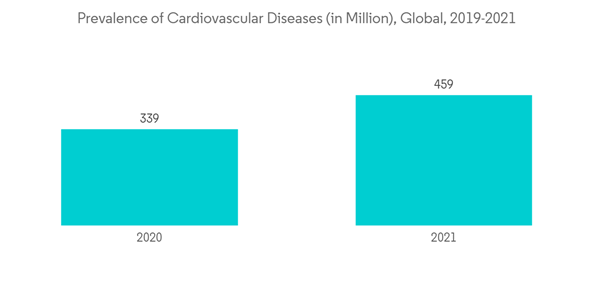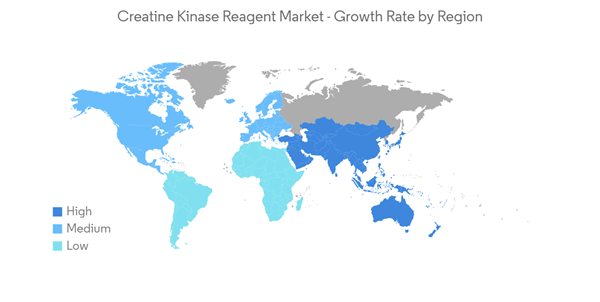The creatine kinase reagent market is anticipated to register a CAGR of nearly 5.5% during the forecast period.
The increasing prevalence of cardiovascular diseases in the United States is driving the growth of the market. According to the CDC's 2022 update, heart disease is the leading cause of death in the United States. The same source also reports that every year about 805,000 Americans have a heart attack. Out of these, 605,000 result in a first-time heart attack, while 200,000 are caused by previous heart attacks. Creatine kinase deficiency eventually leads to congestive heart failure. The huge number of heart attacks creates the opportunity for the high utility of creatine kinase reagents to detect and manage future heart complications, thereby boosting the market growth during the forecast period.
Additionally, as per the February 2022 report from the Heart and Stroke Foundation of Canada, 750,000 people are living with heart failure, and 100,000 people are diagnosed with the condition every year in the country. The same source reported that Canada's healthcare costs associated with heart failure are predicted to reach USD 2.8 billion per year by 2030. Hence, with a high number of heart patients along with the increasing economic burden due to heart failure in the country, the market studied is expected to witness high growth over the forecast period in the North America region.
This product will be delivered within 2 business days.
Key Highlights
- The COVID-19 pandemic had a profound impact on the creatine kinase reagent market. For instance, as per the NLM's article published in May 2021, increased creatine kinase was reported in 9% - 33% of patients with COVID-19. Skeletal muscle injury and myopathies in COVID-19 were associated with increased neutrophils, lymphopenia, C-reactive protein (CRP), increased D-dimer levels, length of ICU stay, and more severe disease.
- Myositis, a subset of myopathy due to inflammation of muscle fibers, has also been reported in patients with COVID-19 in association with elevated creatine kinase values. This, in association with findings of elevated inflammatory cytokines, has led to the hypothesis that COVID-19-induced myopathy may result from the inflammatory cascade. Hence, the pandemic had a negligible impact on the creatine kinase reagent market.
- In addition, the increasing prevalence of cardiovascular diseases and muscular injuries and diseases are actively affecting the growth of the studied market. For instance, according to the World Health Organization (WHO) June 2021 report, cardiovascular disease, which caused an estimated 17.9 million fatalities and 32% of all deaths globally in 2020, is the most common type of chronic disease.
- Also, according to the Australian Bureau of Statistics, an estimated 571,000 Australians aged 18 and over (2.9% of the adult population) had chronic heart diseases in 2021. Hence, the country's high burden of cardiovascular diseases is projected to boost the market growth.
- Furthermore, an article published in Neuroepidemiology Journal in July 2021 stated that combined prevalence rates (per 100,000 people) and incidence rates (per 100,000 person-years) for amyotrophic lateral sclerosis (ALS) were 6.22 and 2.31 for Europe, 5.20 and 2.35 for North America, 3.41 and 1.25 for Latin America, 3.01 and 0.93 for Asian countries excluding Japan, and 7.96 and 1.76 for Japan respectively in 2021.
- Since creatine kinase is used as a marker of muscle damage and is significantly elevated in people with ALS, it is widely used in diagnosing this neurological disease. Hence, the high burden of ALS is projected to boost market growth during the forecast period.
- However, the global market for creatine kinase reagents may be constrained by the strict regulatory frameworks for qualification processes that evaluate companion diagnostics of creatine kinase.
Creatine Kinase Reagent Market Trends
Acute Coronary Syndrome (ACS) Dominates the Market and is Expected to Continue Doing the Same during the Forecast Period
- Acute Coronary Syndrome (ACS) is expected to hold a significant share in the creatine kinase reagent market during the forecast period owing to the rising prevalence of coronary artery diseases (CADs) globally.
- ACS is a result of plaque disruption in coronary arteries. As per the National Institutes of Health (NIH) 2022 statistics, the R&D spending by the government in the United States for atherosclerosis was USD 387 million in 2020, USD 413 million in 2021, and USD 430 million in 2022. The country's increasing research and development spending on atherosclerosis is estimated to boost segment growth.
- The segment's growth is anticipated to impact the increasing elderly population worldwide significantly. The vast population is expected to fuel the segment's expansion because the elderly population is susceptible to many chronic ailments, including acute coronary syndrome.
- For instance, in Sub-Saharan Africa, the population of people 65 and older is expected to be 3.0% by the end of 2022 and will likely increase to 3.3% by 2030. In Northern Africa and Western Asia, the population of people 65 and older is expected to be 5.5% by the end of 2022 and will likely increase to 7.0% by 2030. Similar estimates indicate that it will be 6.4% in Central and Southern Asia in 2022 and 8.1% by 2030. Therefore, the high burden of the geriatric population is anticipated to propel the segment growth during the forecast period.
North America Dominates the Market and is Expected to Continue Doing the Same during the Forecast Period
North America is a prominent market due to well-established end-use industries such as molecular biology laboratories, research institutes, and pharmaceutical companies.The increasing prevalence of cardiovascular diseases in the United States is driving the growth of the market. According to the CDC's 2022 update, heart disease is the leading cause of death in the United States. The same source also reports that every year about 805,000 Americans have a heart attack. Out of these, 605,000 result in a first-time heart attack, while 200,000 are caused by previous heart attacks. Creatine kinase deficiency eventually leads to congestive heart failure. The huge number of heart attacks creates the opportunity for the high utility of creatine kinase reagents to detect and manage future heart complications, thereby boosting the market growth during the forecast period.
Additionally, as per the February 2022 report from the Heart and Stroke Foundation of Canada, 750,000 people are living with heart failure, and 100,000 people are diagnosed with the condition every year in the country. The same source reported that Canada's healthcare costs associated with heart failure are predicted to reach USD 2.8 billion per year by 2030. Hence, with a high number of heart patients along with the increasing economic burden due to heart failure in the country, the market studied is expected to witness high growth over the forecast period in the North America region.
Creatine Kinase Reagent Market Competitor Analysis
The creatine kinase reagent market is highly competitive and consists of global and local players. Due to technological advancements, small and mid-sized companies focus on market penetration to grab market share. New product launches, collaborations, mergers, and acquisitions are the key initiatives undertaken by the leading players in this vertical to sustain the competition. Some of the key companies currently present in the market are Abbott Laboratories, BBI Solutions, Danaher Corporation (Beckman Coulter, Inc.), Boditech Med Inc., DiaSys Diagnostic Systems GmbH, H.U. Group company (Fujirebio), Novus Biologicals, PerkinElmer Inc, Pointe Scientific Inc., Randox Laboratories Ltd, Thermo Fisher Scientific, and Weldon Biotech, Inc.Additional benefits of purchasing the report:
- The market estimate (ME) sheet in Excel format
- 3 months of analyst support
This product will be delivered within 2 business days.
Table of Contents
1 INTRODUCTION
4 MARKET DYNAMICS
5 MARKET SEGMENTATION (Market Size by Value - USD Million)
6 COMPETITIVE LANDSCAPE
Companies Mentioned (Partial List)
A selection of companies mentioned in this report includes, but is not limited to:
- Abbott Laboratories
- BBI Solutions
- Danaher Corporation (Beckman Coulter, Inc.)
- BODITECH MED INC
- DiaSys Diagnostic Systems GmbH
- H.U. Group company (Fujirebio)
- Novus Biologicals
- PerkinElmer Inc.
- Pointe Scientific Inc.
- Randox Laboratories Ltd
- Thermo Fisher Scientific
- Weldon Biotech, Inc.
Methodology

LOADING...










